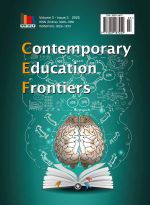Exploring the Design Aesthetic Connotation of “Observing Objects and Taking Images” in Zhouyi
DOI:
https://doi.org/10.18063/cef.v3i3.795Keywords:
Zhouyi (Book of Changes), Guan Wu Qu Xiang (Observing Objects and Deriving Symbols), Design aesthetics, Aesthetic thoughtAbstract
The Book of Changes (Zhouyi) embodies profound cultural wisdom. Its core creative principle, “Observing Objects and Deriving Symbols” (Guan Wu Qu Xiang), provides subsequent generations with invaluable artistic creation concepts and a unique aesthetic framework. Interpreting the Zhouyi from a design aesthetics perspective reveals its extensive content and welldeveloped system; its concepts concerning material creation encompass nearly all dimensions of traditional design aesthetics thought. This paper elucidates the concept of “Observing Objects and Deriving Symbols” and employs the “Li Hexagram” (Li Gua) from the Zhouyi as a specific case for definition and discussion. Through this exploration of its expressed aesthetic thought, the paper aims to uncover the design aesthetics philosophy within the Zhouyi and its profound influence on the cultural essence and stylistic characteristics of traditional Chinese material creation. It constitutes a significant theme within ancient Chinese design aesthetics.
References
Zou F, 2010, “Zhouyi” Design Ideology. Funashan Journal, 2010(3): 74–76.
Li J, Li M, 2019, Exploring the Origin of Zhouyi. Zhong Hua Book Company, China, 201903.423.
Li Y, 2008, “Opening Things into Business”: A Primary Exploration of the Design Thought of “Zhouyi”. Journal of Nanjing Arts Institute (Art and Design Edition), 2008(5): 4–7 + 161.
Chang Y, 2022, The Aesthetic Viewpoint of Zong Baihua’s Zhouyi. Encyclopedic Knowledge, 2022(21): 1–2.
Fu Q, Kong L, 2024, “Xiang”: The Basic Interpretation Unit of the Aesthetics of Zhouyi. Journal of Xi’an College of Arts and Sciences (Social Science Edition), 27(1): 70–73 + 111.
Chen B, 2005, Study on the Aesthetic Thought of Xiangmu in Zhouyi, thesis, Wuhan University.
Chen S, 2019, The Aesthetic Interpretation of Keywords in Zhouyi, thesis, Wuhan University.
Li Q, 2010, Zhouyi and Ecological Aesthetics. Journal of Central South University for Nationalities (Humanities and Social Sciences Edition), 30(6): 132–137.
Zou Y, 1995, Trigrams: Philosophical and Artistic Symbols – A Review of Liu Zangji’s Zhouyi Aesthetics. Chinese Cultural Studies, 1995(2): 143–145 + 4.
Zhong Y, 2010, The Use of “Unity of Heaven and Man” Aesthetic Thought in Environmental Art Design. Journal of Changchun University of Science and Technology, 5(5): 194–195.

